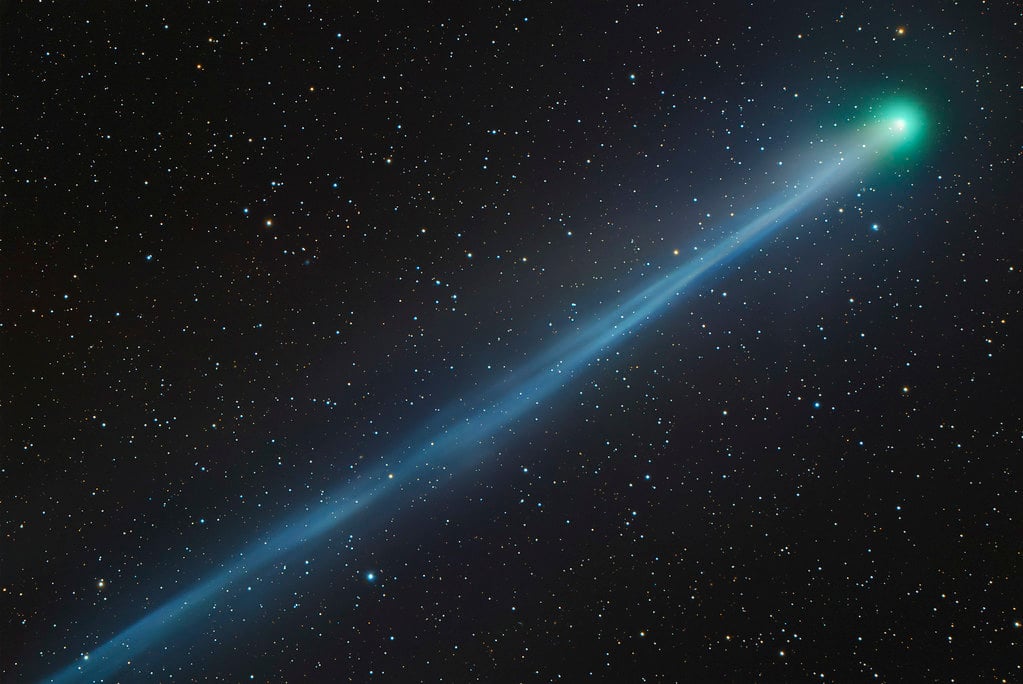A6 Lemmon joins the dusk comet parade, in a brief apparition finale.
Good comets always seem to come in pairs. Flashback to 1997, when we were all awaiting the historic appearance of Comet 1995 O1 Hale-Bopp. Suddenly, another bright comet flared into view: 1996 B1 Hyakutake. These gave us a good study in cometary potential, with a large bright comet seen from a distance in Hale-Bopp, versus a small but relatively nearby fast mover in Comet Hyakutake.
October 2025 sees a similar scene scaled down a bit, as Comet C/2025 A6 Lemmon puts on an encore appearance at dusk. The comet joins Comet R2 SWAN, which slides 0.26 Astronomical Units (AU) past Earth on October 20th. Note that A6 Lemmon passes Earth at about twice that distance, just 24 hours later. Both are currently fine objects for binoculars or a small telescope, vying for top spot at magnitude +6.
Discovered by astronomer D. Carson Fuls during the Mount Lemmon Sky Survey shortly after the beginning of this year on the night of January 3rd, Comet A6 Lemmon shows promise as one of the better comets for 2025.
The comet has proven to be a dependable performer thus far, crossing from the constellation Leo Minor into Ursa Major this past weekend, near the ‘Second Leap of the Gazelle’. This is well below the famous Big Dipper asterism. I caught first sight of the comet on the morning of Saturday, October 4th. The comet appeared as a fuzzy patch in binoculars, looking like a globular cluster that stubbornly refused to snap into focus.
This comet has passed our way before. A6 Lemmon is on a 1350 year orbit inbound, and will have its path tweaked slightly by Jupiter into an 1150 year orbit outbound. This also happened to Comet Hale-Bopp during its 1997 passage. A6 Lemmon reaches perihelion 0.53 AU (79 million kilometers) from the Sun just exterior to Mercury’s orbit on November 8th, and then heads out to a chilly aphelion beyond the main Kuiper Belt at 219 AU from the Sun next millennium sometime around 3175 AD.
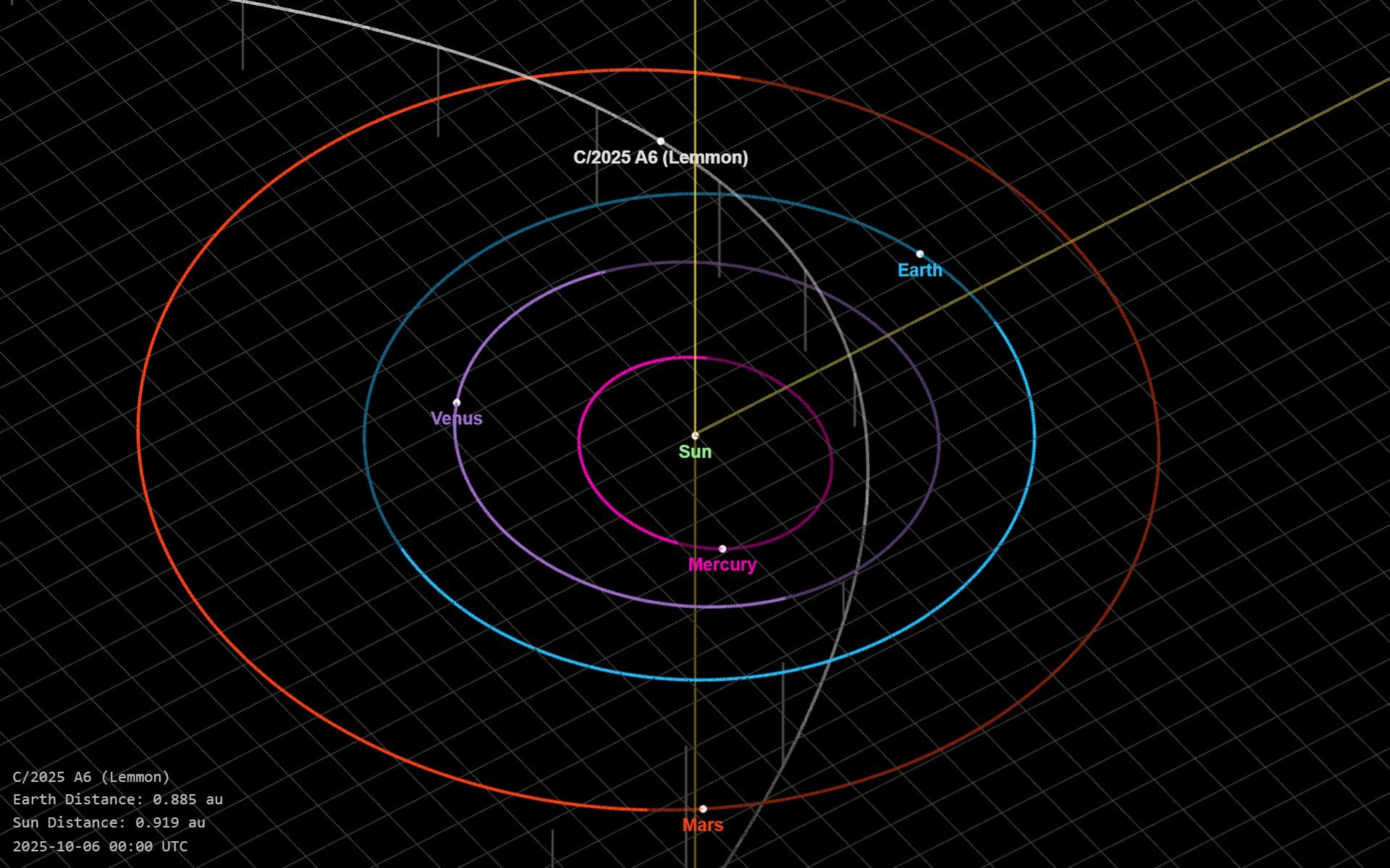 The orbital path of Comet A6 Lemmon through the inner solar system. Credit: NASA/JPL.
The orbital path of Comet A6 Lemmon through the inner solar system. Credit: NASA/JPL.
In the pre-telescopic era, +6th magnitude comets like A6 Lemmon would have easily just slid on by, undocumented. It’s unlikely that anyone took note of this particular comet on its previous passage, 14 centuries ago.
What to Expect in October
First, the good news: as of writing this, Comet A6 Lemmon seems to be brightening slightly ahead of predictions. It maxes out in northern declination on October 10th, and actually goes circumpolar as seen from ‘North of the 50,’ roughly above the latitudes of London in the United Kingdom and Vancouver, Canada northward around the same date. We’re fast losing the comet in the morning sky, as it transitions over to the evening sky for mid-latitude northern hemisphere observers by mid-month.
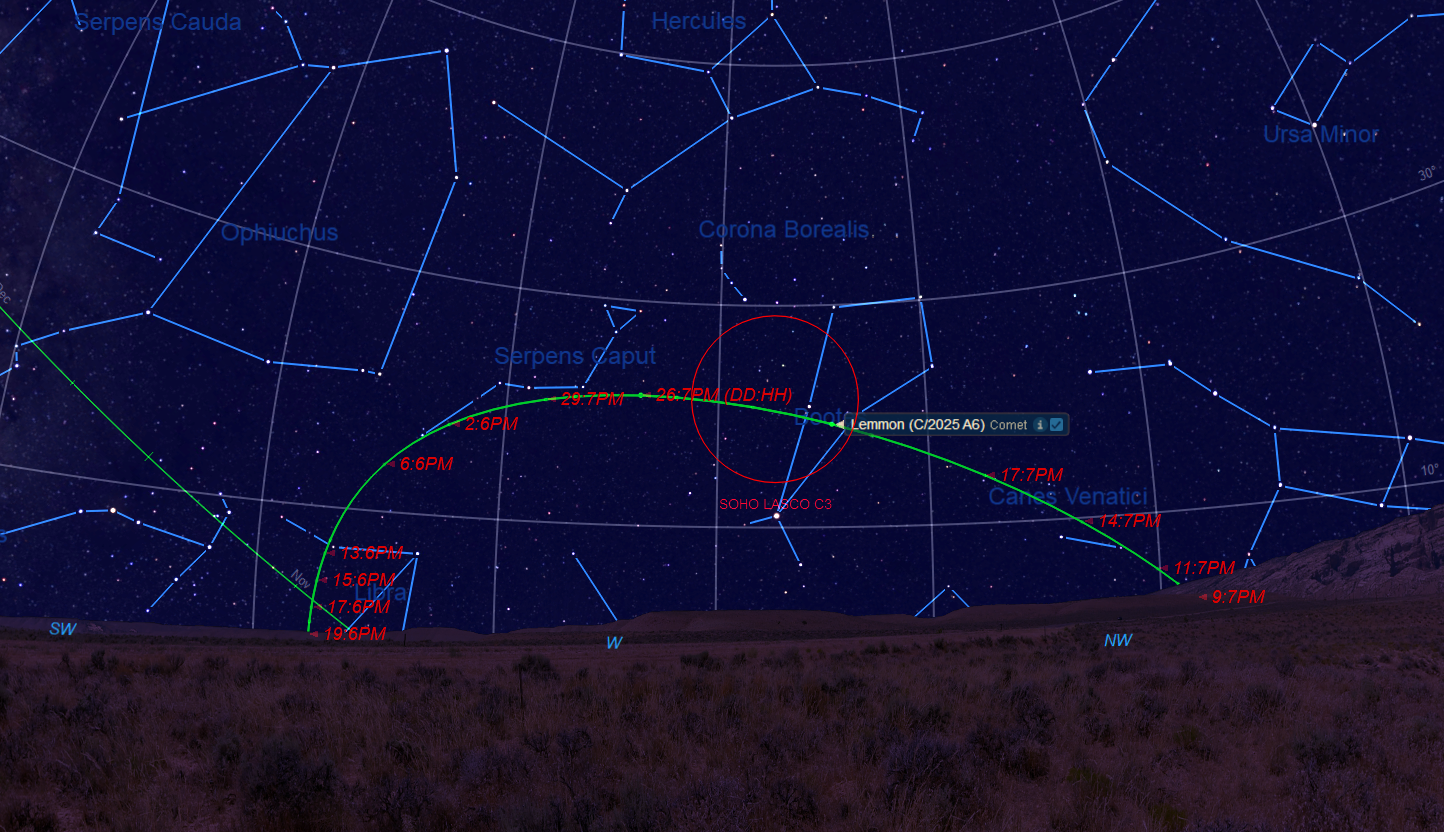 The apparent position of Comet A6 Lemmon from October through November, looking westward from latitude 35 degrees north about 45 minutes after sunset. Credit: Starry Night.
The apparent position of Comet A6 Lemmon from October through November, looking westward from latitude 35 degrees north about 45 minutes after sunset. Credit: Starry Night.
But the evening apparition for Comet A6 Lemmon will be a bashful one. Unlike R2 SWAN which will vault up to the southwest and zoom past the Earth in October, standing out in profile against the post-dusk sky on its outbound leg, A6 Lemmon will hug the western horizon, never getting much higher than 20 degrees for mid-northern latitude viewers an hour after sunset at dusk.
A similar situation occurred with comet C/2011 L4 PanSTARRS in 2013. We can hope that A6 Lemmon kicks off an outburst or two at key times, to help enhance its visibility.
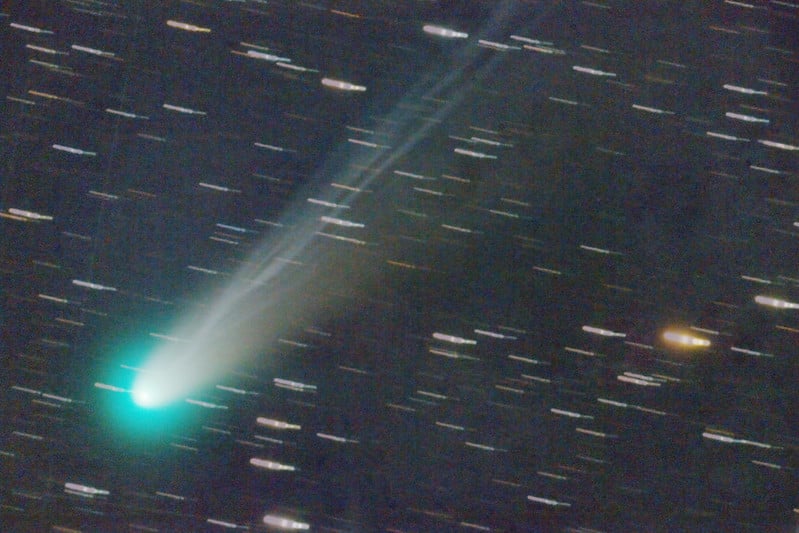 Comet A6 Lemmon from October 4th, showing the evolution of the coma and the tail. Credit: Hisayoshi Kato.
Comet A6 Lemmon from October 4th, showing the evolution of the coma and the tail. Credit: Hisayoshi Kato.
A caveat is always in order when it comes to quoted magnitudes for comets, versus what you can expect to see in the sky. When it comes to stars and small point source objects, we usually think of ‘naked eye’ visibility from a good dark sky site as reaching down to magnitude +6, and binoculars working down to +10, then anything fainter than that is telescopic. Comets, however, have a few things working against them. First, comets are actually intrinsically dark objects. Witness Comet 67P/Churyumov-Gerasimenko visited by the European Space Agency’s Rosetta mission, which had an albedo of just 5% when seen close up, comparable to black-top asphalt.
Second, like extended deep sky objects such as clusters and nebulae, all of that precious magnitude gets ‘smeared out’ over the apparent surface area of the comet’s coma and tail. This all means that a given comet doesn’t generally hit naked eye visibility until it tops +3rd magnitude or so. Likewise, comets don’t really start looking like what the public thinks of as a comet, with a fuzzy head and a tail until at least +1st magnitude or better. Remember Comet F3 NEOWISE in 2020, and A3 Tsuchinshan-ATLAS in 2024? These were the last moderately decent comets in recent memory, ones you could capture simply using a handheld smartphone camera in night mode.
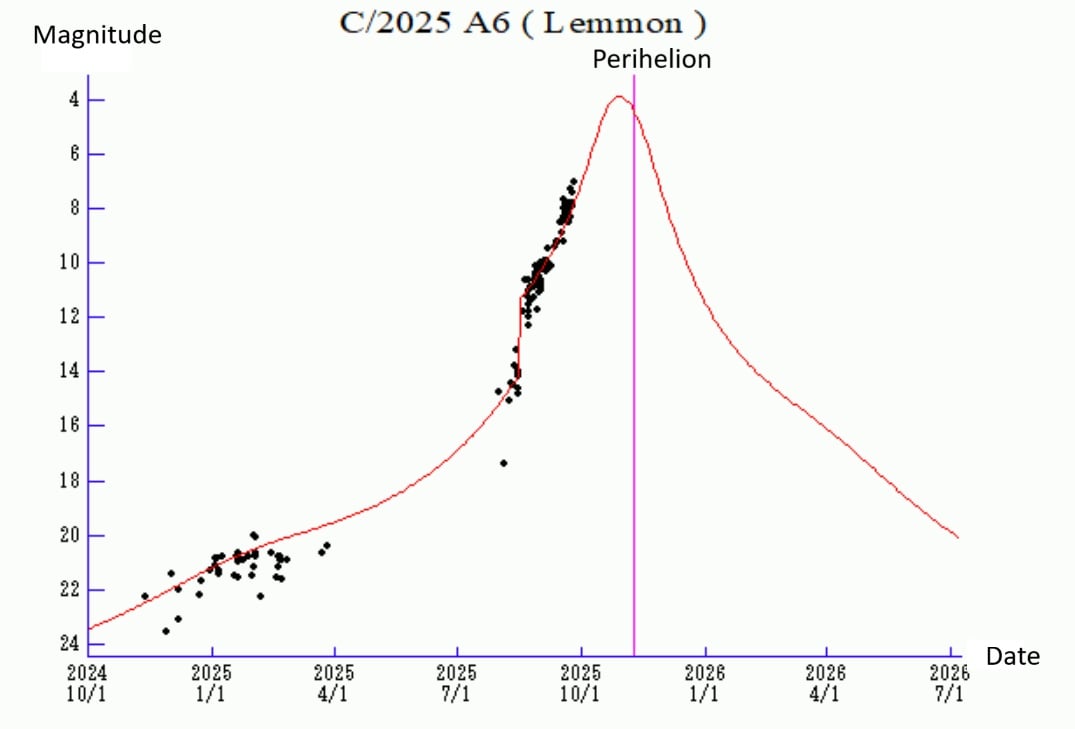 The projected light curve for Comet A6 Lemmon, versus actual observations (black dots). Credit: Adapted from Seiichi Yoshida's Weekly Information About Bright Comets.
The projected light curve for Comet A6 Lemmon, versus actual observations (black dots). Credit: Adapted from Seiichi Yoshida's Weekly Information About Bright Comets.
But don’t let this deter you in your cometary quest. Both comets R2 SWAN and A6 Lemmon should be good evening binocular objects right around Halloween, making them worth showing off to any trick-or-treaters during an impromptu driveway evening star party. The comet then starts to head southward and favors northern hemisphere observers in November, as it heads back out of the solar system.
Also, large light bucket owners may want to go after an extra-special treat: interstellar Comet 3I/ATLAS, also visible in the dusk sky as a +11th magnitude object as it threads its way through the inner solar system. Sure, it’ll just look like a dot, but it’s an interloper from beyond our solar system, a rare sight indeed.
You’ll need to either star-hop or know each comet’s precise nightly position in Right Ascension and Declination to track them down. Though they’re primarily known for satellites, Heavens-Above also has an excellent sub-page for current comets, complete with coordinates and sketch maps.
“Comets are fickle, but if it’s (magnitude) +3 or +4, it will be a nice binocular comet,” astrophotographer Eliot Herman told *Universe Today*. “Try to know where to look in the evening using an app (there are free ones out there, such as Stellarium, then watch the sky dim and try to pick it up. Camera live views are a great substitute for binocs.”
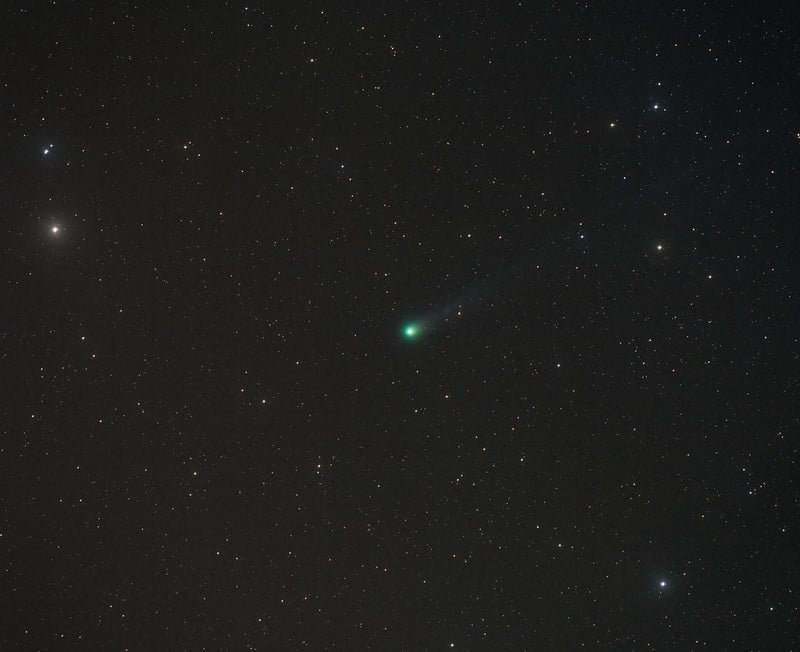 *Comet A6 Lemmon on the morning of September 28th. Credit: Eliot Herman/iTelescope*
*Comet A6 Lemmon on the morning of September 28th. Credit: Eliot Herman/iTelescope*
Here are month-by-month dates with celestial destiny for Comet A6 Lemmon. For our purposes here, ‘passes near’ denotes a pass of with a degree, unless otherwise noted:
October
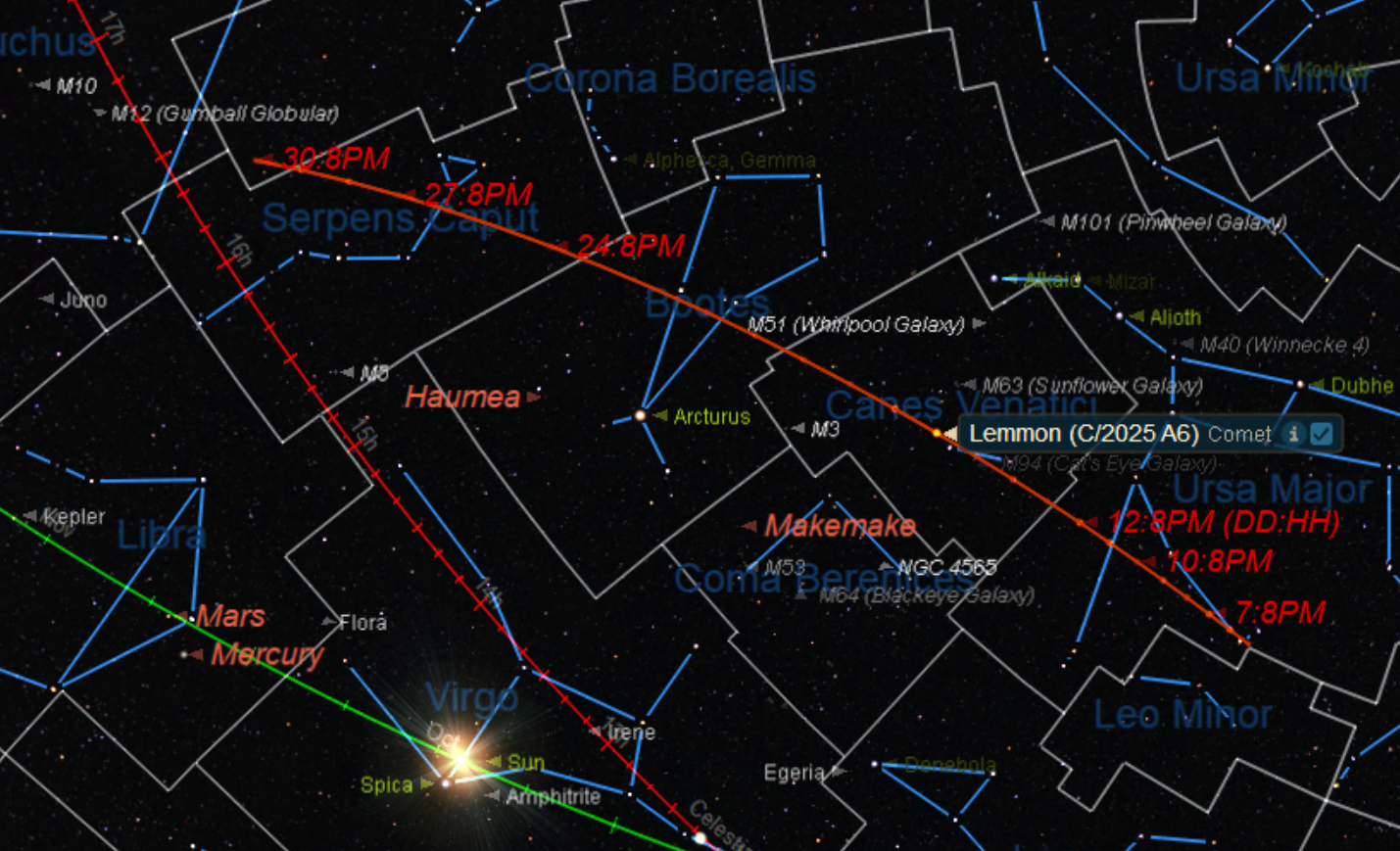 The celestial path of Comet A6 Lemmon through October. Credit: Starry Night.
The celestial path of Comet A6 Lemmon through October. Credit: Starry Night.
6-Crosses into the constellation Ursa Major.
7-Threads the +3rd magnitude stars in the second leap of the Gazelle.
9-Passes near the +4.6 magnitude star Omega Ursae Majoris.
10-Reaches its maximum northern declination, (+42 degrees)
14-Passes into the constellation Canes Venatici.
15-Photo Op: Passes just 2 degrees from Messier 94 (The Black Eye Galaxy).
16-Passes the +2.8 magnitude star Alpha CVn (Cor Caroli).
19-Passes 5 degrees from the globular cluster Messier 3.
20-Crosses into the constellation Boötes the Herdsman.
21-Passes nearest Earth at 0.596 AU distant, moving at an apparent 4 degrees a day across the sky.
22-Passes near the +2.3 magnitude star Epsilon Boötis (Izar).
23-Crosses the ecliptic longitude of the Sun (210 degrees).
25-Crosses into the constellation Serpens Cauda.
31-Nicks the corner of the constellation Hercules.
November
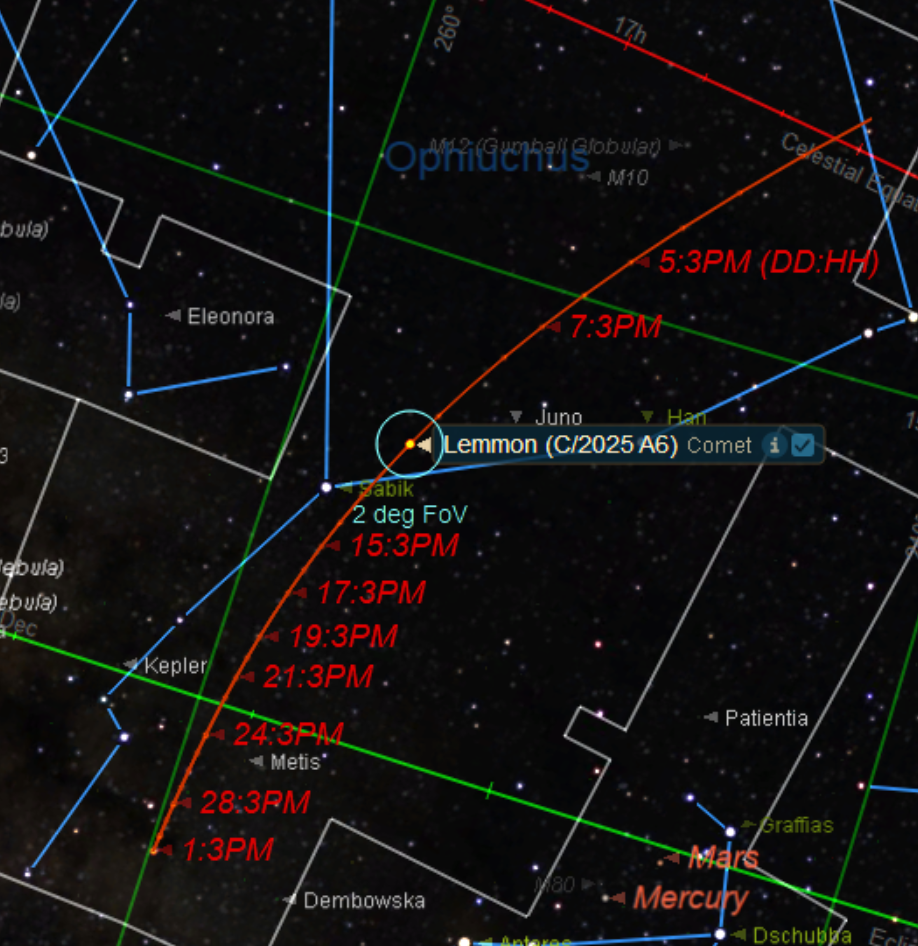 The celestial path of Comet A6 Lemmon through November and perihelion. Credit: Starry Night.
The celestial path of Comet A6 Lemmon through November and perihelion. Credit: Starry Night.
1-Nicks Serpens Cauda again, then crosses into Ophiuchus.
2-Crosses the celestial equator southward.
3-Passes 2 degrees from Messier 12 (The Gumball Nebula).
5-Passes 3 degrees from the Messier 10 globular cluster.
8- Reaches perihelion, at 0.53 AU from the Sun.
13-Passes near the +2.4 magnitude star Eta Ophiuchi (Sabik).
23-Passes through the ecliptic plane southward.
23-Passes just 5 degrees from the planet Mars.
Observing and imaging Comet A6 Lemmon is as easy as sweeping the suspect field of view at low power. Likewise, 10-30 second exposures taken from a tripod-mounted DSLR set to a wide field of view should reveal the comet as a smallish green blob, with a spiky tail. That green is courtesy of cyanogen gas, a hallmark of comets.
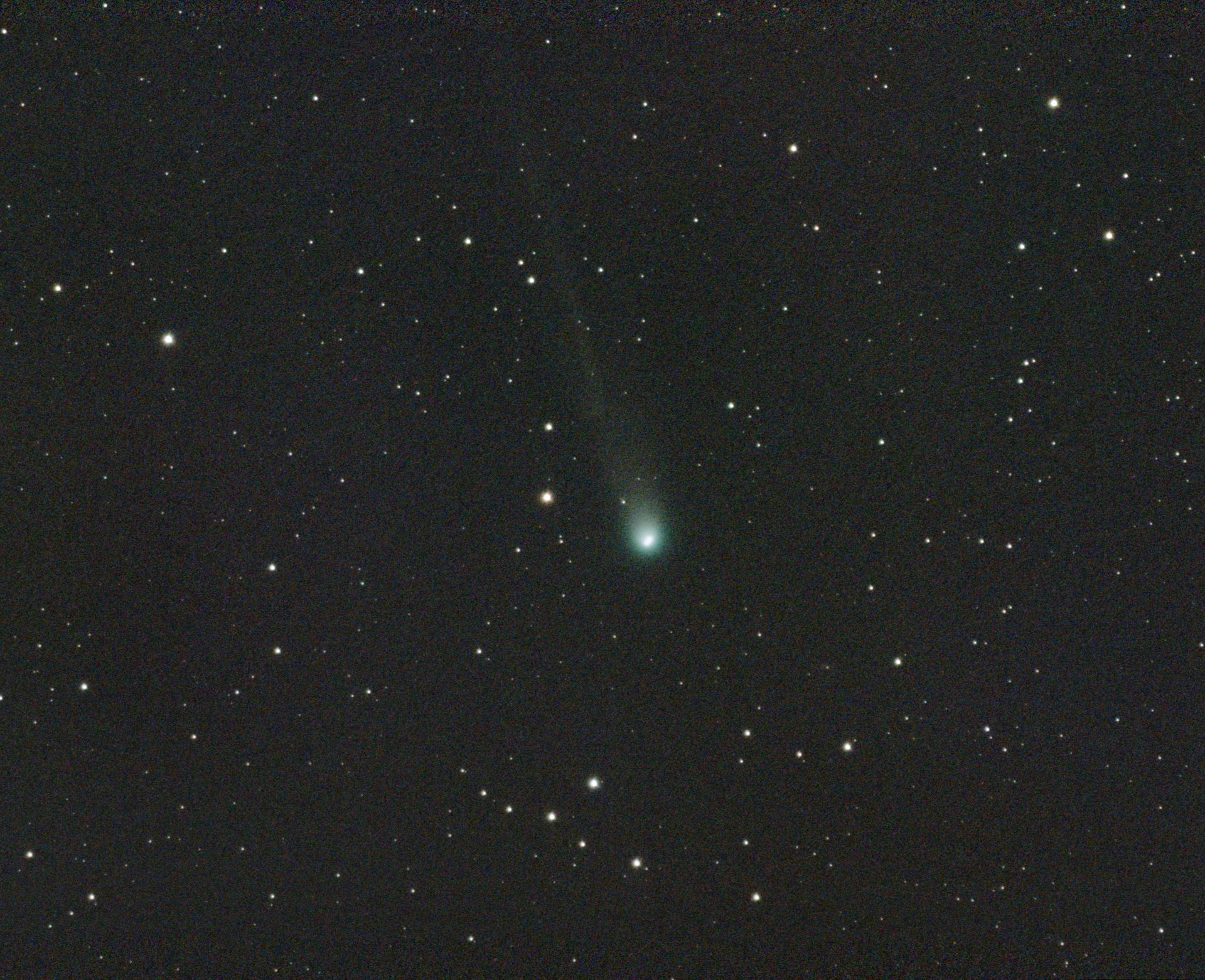 *Comet A6 Lemmon from the morning of October 4th. Credit: Dave Dickinson/DwarfLabs*
*Comet A6 Lemmon from the morning of October 4th. Credit: Dave Dickinson/DwarfLabs*
Look ahead a bit, another recently discovered comet C/2025 R3 PanSTARRS could put on a show early next year, though it’ll be near the Sun (perhaps visible in SOHO’s view) at its best.
Still, it’s something to look forward to in the coming year. Don’t miss the fall feast of binocular comets, currently gracing our October skies.
 Universe Today
Universe Today
